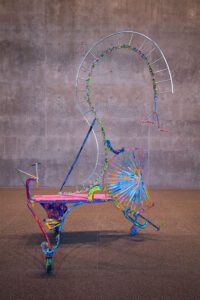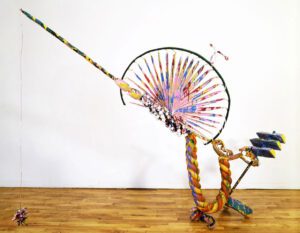SUMMARY: Nancy Graves has taken her sculpture past her initial success with camels. Her work features an uncanny ability to meld disparate materials decisively. She clearly has a superb eye and an inventive mind: Only an adherence to American modernism holds her back.

Colorful, budding bronzes bloom in the sculpture garden of the Hirshhorn Museum in Washington. Sprouting fans and mollusks, as well as palmetto leaves and bean pods, Nancy Graves’s eccentric creations remind one of the line from Andrew Marvell’s “To His Coy Mistress’’: “My vegetable love should grow vaster than empires and more slow.” Though there is nothing slow about this artist. Most of the 49 large and small sculptures in “Nancy Graves: A Sculpture Retrospective” — which later travels to Santa Barbara, Calif., and Brooklyn, N.Y. — suggest a tropical rate of growth. Accompanied by a “Catalogue Raisonne,” with color photographs of each of the 242 three-dimensional works she has created over the past 18 years. The show, organized by the Fort Worth Art Museum in Texas, pays tribute to an astonishingly prolific sculptor.
One of the most appealing qualities of the 46-year-old’s best pieces is the decisiveness with which completely unrelated components are knit together. One has the illusion that the finished sculptures coalesced with uncanny rapidity — that the pod and leaf ends, the calipers and Chinese cooking scissors, the carob beans and sardines were irresistibly drawn to each other under the galvanizing force of the sculptor’s swift eye.
Actually there is a good deal of truth in this description. She neither casts nor welds. Technicians at the foundry where she works cast the plant forms and found objects and then weld them together under her direction. The catalog notes about one sculpture, “The work was assembled in twenty minutes, although the cast parts were made over an eight-week period.”
For the most part, the New Yorker’s hands-on involvement consists of finding the original models for the casts and applying the final patina, enamel or paint. One reason why her bronzes seem so light and bouncy is that there is virtually no record of manual fatigue in their construction, no sensed hesitation before that difficult weld.
But the sculptor’s work confounds critics who feel that it is difficult for artists to be creative with metal unless they weld and cast themselves. With the help of her collaborator, Richard Polich of the Tallix Foundry in Peekskill, N.Y., she has pushed the vocabulary and syntax of contemporary bronze sculpture in three areas — casting, welding and color.
The variety of her cast shapes and surfaces is extraordinarily rich, ranging from the most delicate organic forms through heavy industrial tools to rope, bubble wrap packing material and caning. Her constructions use new welding techniques to cantilever elaborate bundles of objects off a slender stem or to balance heavy masses on such naturally fragile objects as bean pods or paper fans. And finally she emphasizes the lightness and wittiness of her sculptures by articulating their forms with rich and rare patinas, baked enamel and poured acrylic.
Visually, the bronzes are a far cry from the lifelike camels that brought the artist fame in the late 1960s. One of them, looking moth-eaten and truculent, hunches in front of the entryway to the Hirshhorn show. Made of wood, steel, burlap, polyurethane, animal skin, wax, acrylic oil paint and fiberglass, “Mongolian Bactrian (to Harvey Brennan)” (1969) seems unnaturally situated in the precincts of the muses. It would be more at home, one feels, in the nearby National Museum of Natural History.
In view of the personal history of Nancy Graves, that is not surprising. The daughter of a New England museum director, she had observed first hand the creation of dioramas and models of animals. Years later in Florence, Italy, her dormant memories of museum taxidermy were revived by the work of Clemente Susini, an 18th century anatomist who made realistic wax models of human bodies and human and animal organs. Her initial experiments with small stuffed animals led by degrees to the creation of nearly a dozen life-size replicas of two-humped camels complete with dirty, matted brown fur.
These hairy beasts made a sensation when they were exhibited in New York City in 1969. Some critics hated them, others related them to the soft sculptures of Claes Oldenburg and still others thought of them as the ultimate expression of conceptualism in their implicit questioning of the relationship between nature and art. It was not long, however, before Graves moved beyond the replication of a particular biological model to a presentation of more general sculptural concepts.
The formalist milieu in which she matured encouraged object lessons in abstract sculptural categories rather than uniquely interesting forms. The artist responded by calling attention first to the constructive nature of taxidermy in such works as 1970’s “Inside-Outside” and then to the abstract qualities of animal bones. For one large installation the same year she modeled 36 Pleistocene camel leg bones in wax and positioned them upright as if they were walking.
Built into this sculpture is the kind of doublespeak that was endemic to the American art world of the time. Old skeletons fascinate us because death is scary, and long-dead fossils remind us of our own mortality. Leg bones that trot about without bodies are particularly suggestive of ghosties and ghoulies and things that go bump in the night. Yet the sober title for this piece, “Variability of Similar Forms,” suggests that the true connoisseur would suppress these atavistic thoughts and concentrate on the aesthetic appreciation of leg bones as abstract forms. The piece plays head games with the viewer.

The success of her bronzes also rests on the tension between her conceptual approach to construction and the associational power of the objects she assembles. But in these works she uses the associations more creatively to enhance her form and extend its meaning. Thus, “Cantileve” (1983), with its top-heavy headdress and lotus-leaf face, seemingly sways on the tips of two raffia fans like a Chinese woman tottering on bound feet. One does not really know the sculptor’s attitude toward this Oriental allusion; it is simply there to be taken in.
It is quite instructive to compare Nancy Graves’s work with that of Paul Klee, whose retrospective is currently attracting crowds to New York’s Museum of Modern Art (Insight, March 9). Both artists steeped themselves in biology as preparation for the creation of abstract forms. Both are fascinated by the laws that govern structure in both nature and artistic design.
But where Klee’s grounding in German Idealism allowed him to make further conscious leaps into metaphor, metaphysics and the nature of the human condition, Nancy Graves, weighed down by bedrock American pragmatism, contents herself with cautious references to archaeology, anthropology and — above all — to art history. Thus, “Agni” (1982), made following a trip to India, twists yellow bean pods into an approximation of the god Siva’s dancing arms and legs. And “Biianx” (1982) suggests a Degas bronze dancer. Picasso and David Smith also appear in colorful guises.
Graves’s sculpture is most effective when it is most direct and least labored. Former Fort Worth senior curator Diane Upright and others from the museum have included a good selection of pieces from the early 1980s, when the artist was in top form. Such sculptures as “Colubra” and “Kylix,” both from 1982, and “Et Sec,” made in 1983, are magical in their transmutation of clearly articulated, relatively simple forms into works of rare personality, grace and wit. The polychrome patinas coloring these efforts are more subtle and resonant than the dripped polyurethane paint the sculptor currently favors.
The later and more florid works, several with moving parts, are less successful. Their complicated structures seem to have little point, and their bright paint spatters are funky but not particularly arresting or meaningful. Still there are such moments of delight as “Wheelabout” (1985), an outrageous spoof of Smith.
Judging by the sculpture on view at the Hirshhorn — through April 26 — the featured artist has a superb eye and a restlessly inventive mind. She also has trained herself to penetrate beyond appearances to the structural laws that govern natural forms, so the internal rhythms of her assemblages are rigorous and disciplined in spite of the Dadaist spirit of invention that animates them. It is difficult to think of any other contemporary American sculptor who has her range or her dynamism.
But one senses a confusion in Nancy Graves’s sculptural aims borne of the disparity between her wildly inventive imagination and the straitjacketing influence of doctrinaire American modernism. Missing are the emotional connection and aesthetic coherence that would allow her to compete with David Smith in the front ranks of American 20th century sculpture.
Jane Addams Allen 1987
